Intel Xeon E Six-Core Review: E-2186G, E-2176G, E-2146G, and E-2136 Tested
by Ian Cutress on November 5, 2018 12:00 PM EST- Posted in
- CPUs
- Intel
- Xeon
- Enterprise CPUs
- Xeon E
CPU Performance: Office Tests
The Office test suite is designed to focus around more industry standard tests that focus on office workflows, system meetings, some synthetics, but we also bundle compiler performance in with this section. For users that have to evaluate hardware in general, these are usually the benchmarks that most consider.
All of our benchmark results can also be found in our benchmark engine, Bench.
PCMark 10: Industry Standard System Profiler
Futuremark, now known as UL, has developed benchmarks that have become industry standards for around two decades. The latest complete system test suite is PCMark 10, upgrading over PCMark 8 with updated tests and more OpenCL invested into use cases such as video streaming.
PCMark splits its scores into about 14 different areas, including application startup, web, spreadsheets, photo editing, rendering, video conferencing, and physics. We post all of these numbers in our benchmark database, Bench, however the key metric for the review is the overall score.
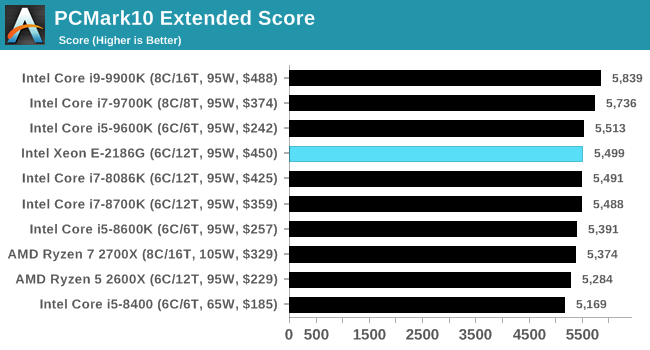
There's a slight issue using PCMark with having IGP drivers installed then restarting the system using a discrete GPU installed. We'll come back and rerun when the time permits.
Chromium Compile: Windows VC++ Compile of Chrome 56
A large number of AnandTech readers are software engineers, looking at how the hardware they use performs. While compiling a Linux kernel is ‘standard’ for the reviewers who often compile, our test is a little more varied – we are using the windows instructions to compile Chrome, specifically a Chrome 56 build from March 2017, as that was when we built the test. Google quite handily gives instructions on how to compile with Windows, along with a 400k file download for the repo.
In our test, using Google’s instructions, we use the MSVC compiler and ninja developer tools to manage the compile. As you may expect, the benchmark is variably threaded, with a mix of DRAM requirements that benefit from faster caches. Data procured in our test is the time taken for the compile, which we convert into compiles per day.
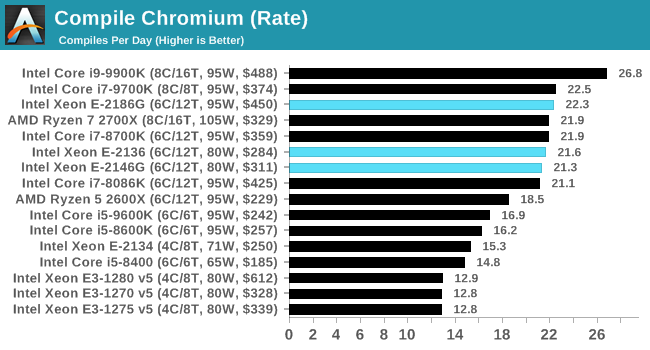
3DMark Physics: In-Game Physics Compute
Alongside PCMark is 3DMark, Futuremark’s (UL’s) gaming test suite. Each gaming tests consists of one or two GPU heavy scenes, along with a physics test that is indicative of when the test was written and the platform it is aimed at. The main overriding tests, in order of complexity, are Ice Storm, Cloud Gate, Sky Diver, Fire Strike, and Time Spy.
Some of the subtests offer variants, such as Ice Storm Unlimited, which is aimed at mobile platforms with an off-screen rendering, or Fire Strike Ultra which is aimed at high-end 4K systems with lots of the added features turned on. Time Spy also currently has an AVX-512 mode (which we may be using in the future).
For our tests, we report in Bench the results from every physics test, but for the sake of the review we keep it to the most demanding of each scene: Ice Storm Unlimited, Cloud Gate, Sky Diver, Fire Strike Ultra, and Time Spy.
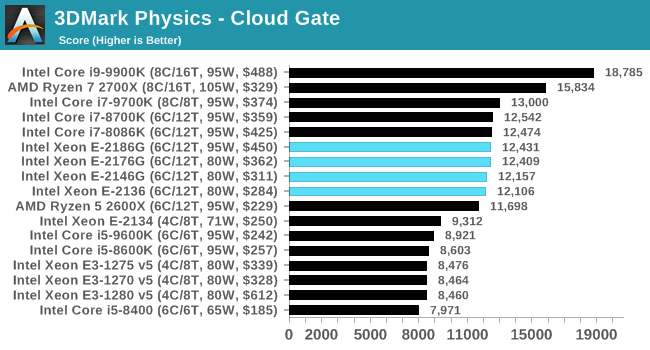
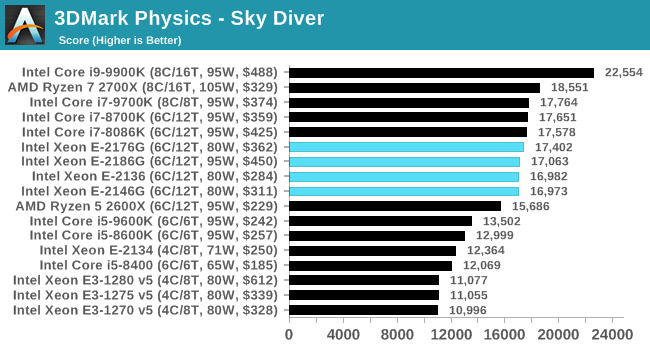
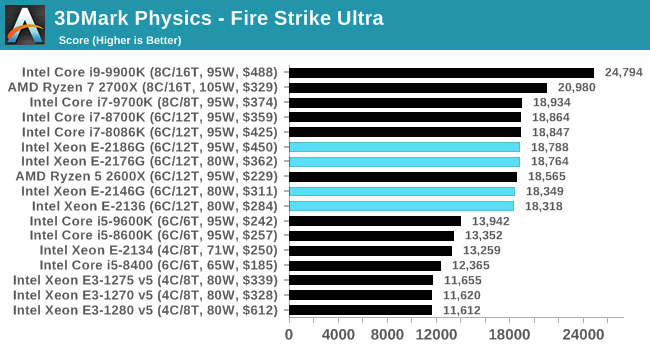
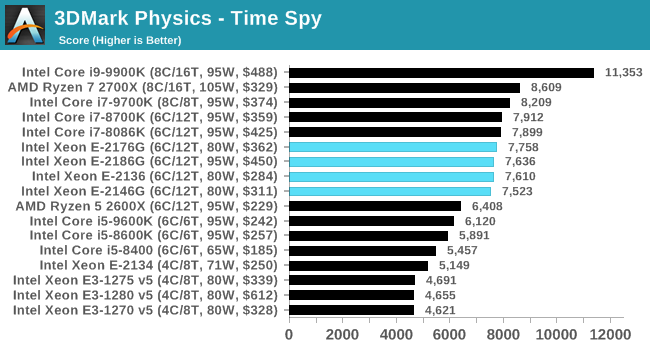
GeekBench4: Synthetics
A common tool for cross-platform testing between mobile, PC, and Mac, GeekBench 4 is an ultimate exercise in synthetic testing across a range of algorithms looking for peak throughput. Tests include encryption, compression, fast Fourier transform, memory operations, n-body physics, matrix operations, histogram manipulation, and HTML parsing.
I’m including this test due to popular demand, although the results do come across as overly synthetic, and a lot of users often put a lot of weight behind the test due to the fact that it is compiled across different platforms (although with different compilers).
We record the main subtest scores (Crypto, Integer, Floating Point, Memory) in our benchmark database, but for the review we post the overall single and multi-threaded results.
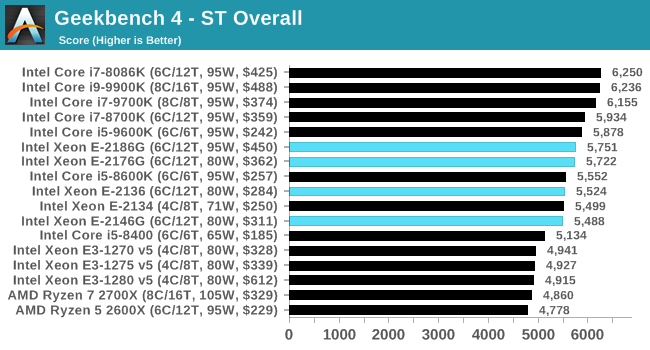











48 Comments
View All Comments
unsleepable - Thursday, November 8, 2018 - link
Any word on the lower-power members of the family? I imagine Intel will still release equivalents to previous generation processors like the Xeon E3-1260L v5, or counterparts to the i7 T CPUs like the Core i7-8700T, right?Chaitan - Saturday, November 10, 2018 - link
There is an interesting statement for these CPUs on ark: "Support for up to 128GB system memory capacity will be available in 2019 through a published BIOS Update. Please contact your hardware provider for availability and support."Does it mean that these will be the first mainstream CPUs with officially provided microcode for Intel memory controller to support 128GB?
Laptops with 128GB RAM support were announced several months ago by Dell, Lenovo and MSI (the latter with desktop CPUs and C246 chipset), but so far CPUs and BIOS for these laptops require custom OEM-specific CPU microcode for memory controller to really support such capacity.
Madao - Saturday, November 10, 2018 - link
I got lucky; got a 2176G on my doorstep from Provantage like Oct 20 for $330. X11SCA-W was in stock on newegg at the same time. I wanted the cheaper ASUS board but it was in stock nowhere.Really pisses me off that AMD and mobo makers dropped the ball on ECC. It should be standard in all computers and even phones. It only needs a few extra ram traces ffs --;
rannyjohns - Thursday, November 15, 2018 - link
I love your blog. And I always find something new here that I either hadn’t seen before or somehow managed to pass over. Thank you for this post! I am recently hoping to reach out and build my network in order to have more of a true collaboration going on, try more solution withasgehrj - Friday, December 14, 2018 - link
I'm not sure I agree that the only reason to get the top model is bragging rights.Agreed, turbo speed is very close to the lower end models, but:
It can sustain a 15% faster base clock than the lower end models, which is meaningful in e.g. render time. (It would almost equal an imaginary 7 core 2136)
"So buy a cpu with more cores" I hear you say...
True in most cases, but I'm building a 3D workstation, where the CAD application likes high single core clock speed , which is hard to find in the models with even more cores. The same machine also does the rendering, so in this case I'm pretty sure the 2186G (or the ..76G) is the better choice.